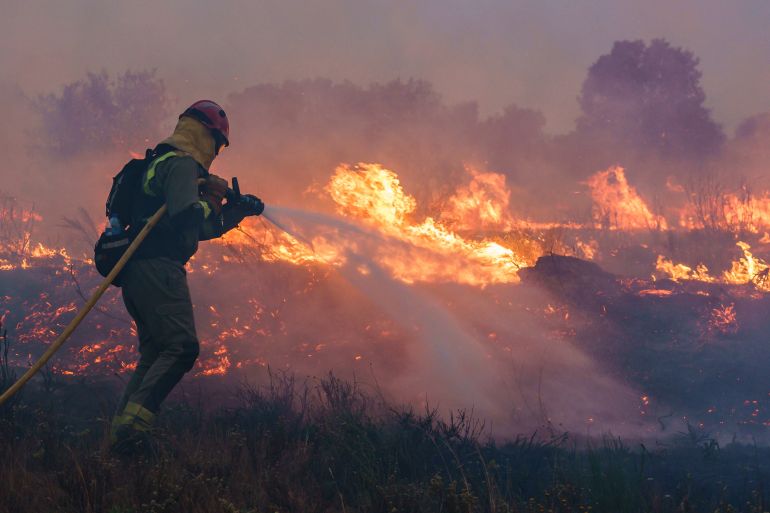Spain, Germany battle wildfires amid unusual heatwave in Europe
Experts have linked the abnormally hot period in parts of Europe to climate change amid high temperatures and low rainfall.

Firefighters in Spain and Germany are struggling to contain wildfires amid a heatwave in Western Europe, unusual for this time of year.
The worst damage in Spain has been in the northwest province of Zamora where more than 25,000 hectares (61,000 acres) have been consumed by flames, regional authorities said on Sunday. German officials said residents of three villages near Berlin were ordered to leave their homes on Sunday because of an approaching wildfire.
Keep reading
list of 4 itemsEarth’s CO2 level passes a new climate milestone
Can MENA countries fight climate change the same way?
Biden urges climate action under spectre of fuel crisis
Experts have linked this abnormally hot period for Europe to climate change.
Mercury rose above 40 degrees Celsius (104 degrees Fahrenheit) in many Spanish cities throughout the week – such temperatures that are usually expected in August.
A lack of rainfall this year, combined with gusting winds, has also produced the conditions for the fires.
Following three days of high temperatures, strong winds and low humidity, some respite came on Sunday with dropping temperatures that allowed for about 650 firefighters, supported by water-dumping aircraft, to establish a perimeter around the fire that started in Zamora’s Sierra de la Culebra.
Authorities warned there was still danger that an unfavourable shift in weather could revive the blaze that has already caused the evacuation of 18 villages.
Authorities said gusting winds of up to 70kmph (43mph) that changed course erratically, combined with temperatures near 40C, made it very tough for fire crews to fight the blazes.
“The fire was able to cross a reservoir some 500 metres [1,640 feet] wide and reach the other side, to give you an idea of the difficulties we faced,” Juan Suárez-Quiñones, an official for Castilla y León region, told the Spanish state television TVE.
The fire in Zamora was started by a strike from an electrical storm on Wednesday, authorities said. The spreading fire caused the high-speed train service from Madrid to Spain’s northwest to be cut on Saturday. It was re-established on Sunday morning.
Spanish military firefighting units have been deployed in Zamora, Navarra and Lleida.
There have been no reports of lives lost, but in central-north Navarra authorities have evacuated some 15 small villages as a precaution. High temperatures in the area are not expected to drop until Wednesday.
“The situation remains delicate. We have various active fires due to the extremely high temperatures and high winds,” Navarra regional vice president Javier Remírez told TVE.
Some wild animals had to be evacuated from an animal park in Navarra and taken to a bull ring for safekeeping, authorities said.
Wildfires were also active in three parts of northeast Catalonia: in Lleida, in Tarragona and in a nature park in Garaf, just south of Barcelona.
In Germany, strong winds fanned a blaze about 50km (31 miles) southwest of Berlin, prompting officials to declare an emergency on Saturday.
Villagers in Frohnsdorf, Tiefenbrunnen and Klausdorf were told to immediately seek shelter at a community centre in the nearby town of Treuenbrietzen.
“This is not a drill,” town officials tweeted.
Germany has seen numerous wildfires in recent days following a period of intense heat and little rain.
The country’s national weather agency said the mercury topped 38C (100.4F) at some measuring stations in the east on Sunday.
Thunderstorms were forecast to bring cooler weather in from the west from the evening onward.